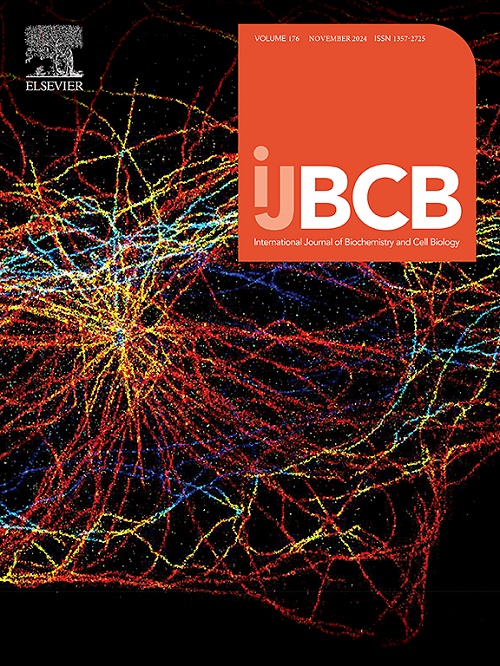Cannabigerol – A potent regulator of insulin sensitivity in rat’s skeletal muscle via targeting the sphingolipid metabolism and PI3K/Akt/mTOR pathway?
IF 2.8
3区 生物学
Q2 BIOCHEMISTRY & MOLECULAR BIOLOGY
International Journal of Biochemistry & Cell Biology
Pub Date : 2025-06-06
DOI:10.1016/j.biocel.2025.106819
引用次数: 0
Abstract
Despite the great advances in medicine, there is a compelling need to develop alternative strategies to effectively treat obesity with the use of plant-origin therapeutics. Cannabigerol (CBG) appears to be a novel promising compound for managing this increasingly prevalent disease requiring multifaceted pharmacotherapy. Therefore, the herein study aimed to evaluate the potential therapeutic properties of 2-week CBG administration on the muscular metabolism of sphingolipids as well as insulin signal transduction pathway in a rat model of obesity and insulin resistance (IR) induced by high-fat, high-sucrose (HFHS) diet. The high-performance liquid chromatography (HPLC) and ultra-high performance liquid chromatography-tandem mass spectrometry (UHPLC/MS/MS) were used to determine the sphingolipids content, while the multiplex assay kit was applied to measure the level of the phosphorylated form of proteins from the PI3K/Akt/mTOR pathway. The expression of various proteins engaged in the sphingolipid metabolism and insulin signaling was assessed using Western blotting. Our results showed that 2-week CBG treatment decreased the muscular content of most deleterious C16:0-Cer and C18:0-Cer ceramide species and reduced the intramuscular concentrations of sphinganine (SFA) and sphingosine (SFO), redirecting their metabolism toward phosphorylated derivatives, sphinganine-1-phosphate (SFA1P), and sphingosine-1-phosphate (S1P), respectively. Simultaneously, CBG counteracted S1P efflux in skeletal muscle, inhibiting the tissue-specific S1P/S1PR3 signaling. CBG also activated the PI3K/Akt/mTOR pathway, which increased the phosphorylation of protein kinase B (Akt) and its downstream targets in the myocytes of obese rats. These results suggest that CBG may play an essential homeostatic role in skeletal muscles and can protect from the development of obesity-associated metabolic derangements.

大麻酚-通过靶向鞘脂代谢和PI3K/Akt/mTOR通路有效调节大鼠骨骼肌胰岛素敏感性?
尽管医学取得了巨大的进步,但迫切需要开发替代策略,利用植物来源的疗法来有效治疗肥胖。大麻酚(CBG)似乎是一种新的有前途的化合物,用于管理这种日益普遍的疾病,需要多方面的药物治疗。因此,本研究旨在评估2周CBG对高脂高糖饮食诱导的肥胖和胰岛素抵抗(IR)大鼠肌肉鞘脂代谢和胰岛素信号转导通路的潜在治疗作用。采用高效液相色谱法(HPLC)和超高效液相色谱-串联质谱法(UHPLC/MS/MS)检测鞘脂含量,采用多重检测试剂盒检测PI3K/Akt/mTOR通路磷酸化蛋白的水平。Western blotting检测参与鞘脂代谢和胰岛素信号传导的各种蛋白的表达。我们的研究结果表明,2周的CBG处理降低了肌肉中最有害的C16:0-Cer和C18:0-Cer神经酰胺种类的含量,降低了肌内鞘氨酸(SFA)和鞘氨醇(SFO)的浓度,使它们的代谢分别转向磷酸化衍生物鞘氨氨酸-1-磷酸(SFA1P)和鞘氨醇-1-磷酸(S1P)。同时,CBG抵消骨骼肌中的S1P外排,抑制组织特异性S1P/S1PR3信号。CBG还激活了PI3K/Akt/mTOR通路,增加了肥胖大鼠肌细胞中蛋白激酶B (Akt)及其下游靶点的磷酸化。这些结果表明CBG可能在骨骼肌中发挥重要的体内平衡作用,并可以防止肥胖相关代谢紊乱的发生。
本文章由计算机程序翻译,如有差异,请以英文原文为准。
求助全文
约1分钟内获得全文
求助全文
来源期刊
CiteScore
8.10
自引率
0.00%
发文量
124
审稿时长
19 days
期刊介绍:
IJBCB publishes original research articles, invited reviews and in-focus articles in all areas of cell and molecular biology and biomedical research.
Topics of interest include, but are not limited to:
-Mechanistic studies of cells, cell organelles, sub-cellular molecular pathways and metabolism
-Novel insights into disease pathogenesis
-Nanotechnology with implication to biological and medical processes
-Genomics and bioinformatics

 求助内容:
求助内容: 应助结果提醒方式:
应助结果提醒方式:


